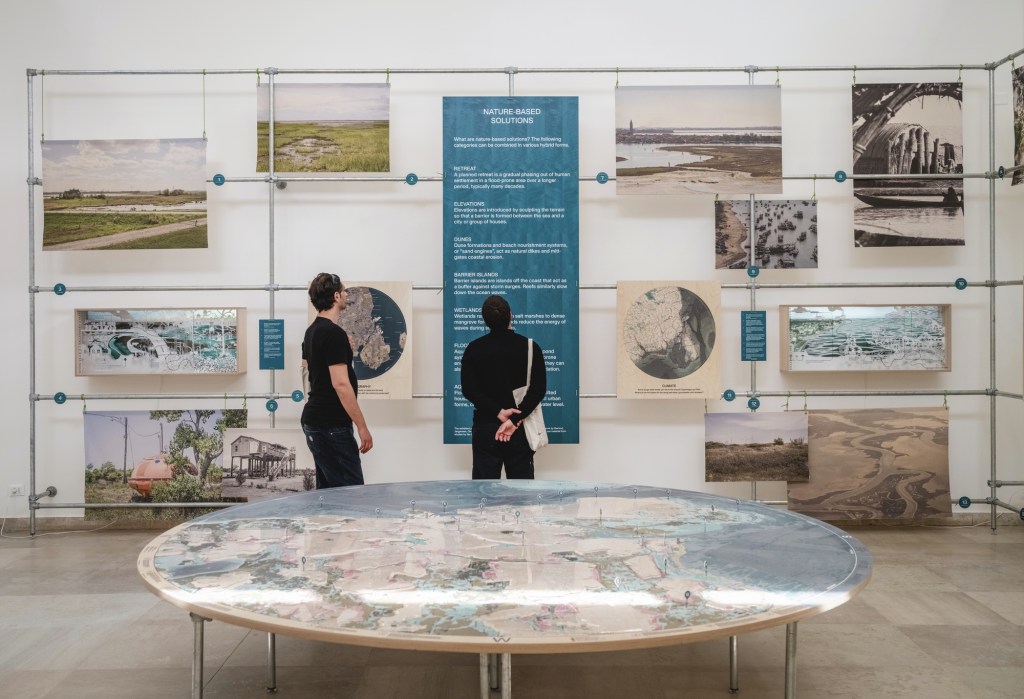The 18th International Architecture Exhibition at the Venice Biennale officially kicks off on May 20. Adopting a “Laboratory of the Future” theme, the show—curated by Ghanaian-Scottish architect and academic Lesley Lokko, and running through Nov. 26—will feature 60-plus national pavilions from countries around the world.
Exploring critical issues including rising sea levels, the consequences of deforestation, the vital need for safe, affordable housing, and much more, here are nine exhibitions to watch out for.
Argentina: El Futuro del Agua
Blueness fills the space inside a brick-lined, otherwise unadorned room. Climbing 70 centimeters up the wall, the solid color conjures the theme of Argentina’s contribution, El Futuro del Agua, created by architect Diego Arraigada to reflect on the nation’s relationship to water and the dangers of unchecked rising sea water levels. Informational texts presented in slim, rectangular display cases resting on narrow table legs seem to float about the room, their presence a ballast for thinking about how to address increasingly challenging conditions. The pavilion, especially as seen in the context of Venice and its own troubled relationship to rising sea levels, pushes viewers to go beyond sinking into their despair and into action.
Brazil: Terra [Earth]
Brazil holds an outsize influence on the future of the planet. Due to the rampant deforestation of the country’s Amazon rainforest carried out under former president Jair Bolsonaro, the rainforest now emits more CO2 than it captures—and impacts the whole planet beyond Brazil’s borders. Recognizing this, co-curators Gabriela de Matos and Paulo Tavares have created Terra [Earth], which incorporates Brazilian soil into the display. The show also utilizes the sankofa, a visual icon of a bird used in many Brazilian public housing projects inspired by the Akan peoples of West Africa. Challenging the colonialist imposition of Brasilia, a city built from scratch to become the nation’s capital, in one gallery and honoring Indigenous and Afro-Brazilian traditions in an accompanying space, the curators are “thinking of Brazil as earth…. Earth as soil, fertilizer, ground, and territory,” according to the Biennial Foundation, and the vital role it will continue to play in our shared fate on this planet.
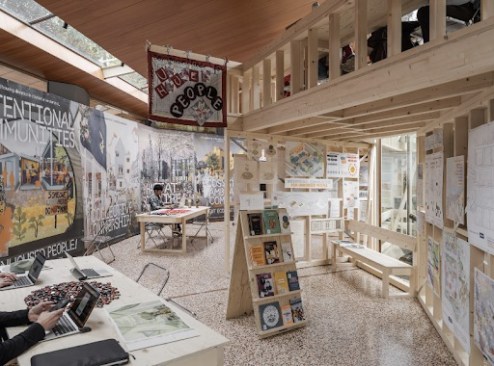
courtesy Canada Council for the Arts
Part of the Not for Sale! exhibition.
Canada: Not for Sale!
For its selection, Canada highlights the work of Architects Against Housing Alienation, a newly formed research collective of architects, designers, educators, and historians advocating for radical transformations to housing markets that promote safe, affordable housing for all, including efforts to decommodify the housing market and return land to Indigenous populations. The group’s exhibit, Not for Sale!, will incorporate perspectives from Indigenous communities, educators, and affordable housing practitioners aiming to “instigate an architectural movement and create socially, ecologically, and creatively empowering housing for all,” according to a Canadian Architect article.
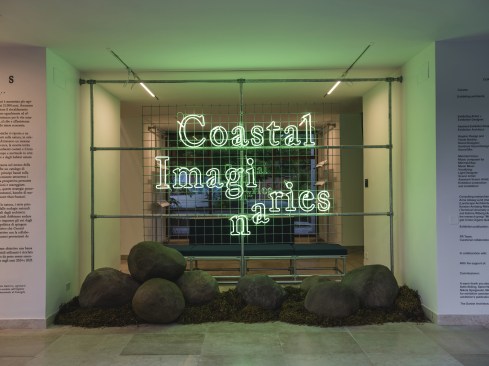
Rasmus Hjortshøj/courtesy The Danish Architecture Centre
An installation from Coastal Imaginaries.
Denmark: Coastal Imaginaries
Argentina is not the only country grappling with rising sea levels. For the Danish pavilion, curator Josephine Michau’s Coastal Imaginaries tackles these questions from overlapping perspectives, from the challenges of CO2 capture and habitat preservation for other species to the need for solutions that also provide recreation and protection for residents of cities like Copenhagen. Michau insists on design approaches “based on hope and an optimistic vision of the future,” according to a statement from the Danish Architecture Center. The pavilion’s proposed projects—like an immersive audiovisual depiction of the Danish coastline, developed in collaboration with landscape architects, architecture students and visual artists—respond to the specific qualities of Denmark’s coastline for inspiration.
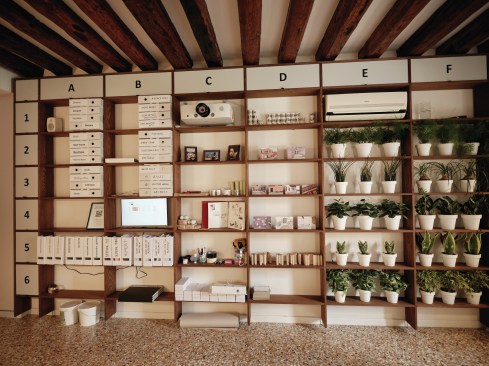
Kertin Vasser
A look at Home Stage.
Estonia: Home Stage
Caught up in webs of financial speculation and gentrification, secure housing is not guaranteed for many people, a challenge that informs Estonia’s contribution to the Biennale. With Home Stage, Aet Ader, Arvi Anderson, and Mari Möldre of b210 Architects transform a Venice apartment near the Arsenale complex with 90-minute performance art pieces that explore the contradictions of modern living. With themes like “Bed sheets / Spreadsheets” and “Warm bath / Cold deal,” each performance will open the domestic space to its viewers in surreal and poetic ways.
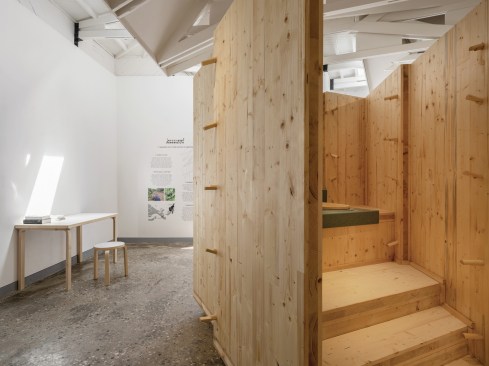
Ugo Carmeni
View of Hussi – Imagining the Future History of Sanitation.
Finland: Hussi – Imagining the Future History of Sanitation
It’s 2043, and the flushable toilet is a thing of the past. That’s the vision of Huussi – Imagining the Future History of Sanitation, staged by architecture and design group The Dry Collective, as part of its installation on behalf of Finland. Emphasizing the long tradition of the huussi, a Finnish composting toilet often used in rural areas and vacation homes, the installation challenges our reliance on flushable toilets, which use 30% of domestic water consumed in developed nations. With both carbon fertilizers and wastewater treatment sapping the planet of much-needed resources, widespread adoption of compostable toilets that generate sustainable fertilizers will be vital to creating livable futures.
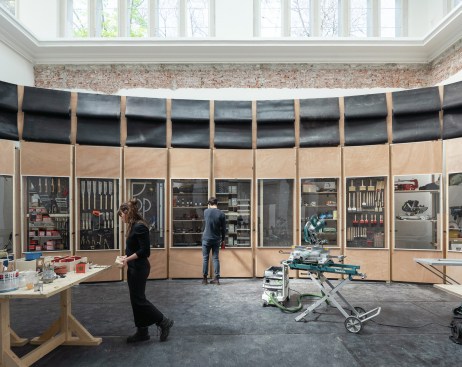
courtesy ARCH+ SUMMACUMFEMMER BUERO JULIANE GREB
A scene from Open for Maintenance.
Germany: Open for Maintenance
Everything is falling apart. Our homes, cities, and the planet at large are in disrepair, with once-beloved structures collapsing due to neglect. With Open for Maintenance, German architecture publication Arch+ and firms Summacumfemmer and Büro Juliane Greb reveal the work required to maintain any building façade and how easily it is left behind. In a Biennale first, the project repurposes building supplies from more than 40 of last year’s Venice Biennale pavilions and exhibitions (including Germany’s). Utilizing the space as a laboratory to explore better forms of care, the pavilion disrupts the wastefulness of exhibitions past.
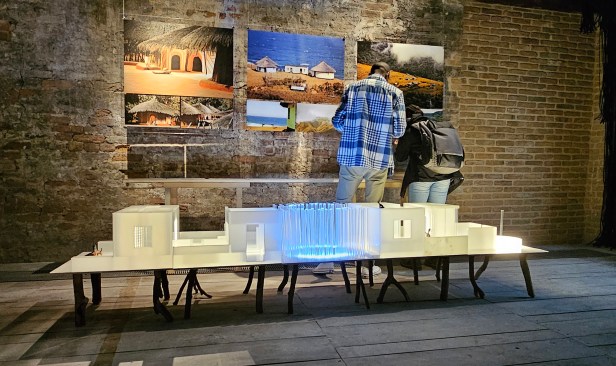
courtesy
Inside The Structure of a People.
South Africa: The Structure of a People
Colonialism is a destructive force, erasing the many ways that Indigenous inhabitants have lived and used space across time. Still, those communities find ways of persisting, passing down their cultural legacies to inform futures that honor what has seemingly been lost. In that tradition, South African curators Stephen Steyn, Emmanuel Nkambule, and Sechaba Maape have envisioned The Structure of a People, which incorporates research into the Bokoni, an ancient civilization that once created plans for more than 10,000 square kilometers of land in Mpumalanga, about 200 kilometers east of Johannesburg. Through careful investigations, immersive virtual recreations of the land as it appeared during that time, and a display of an original Bokoni stone engraving depicting the group’s spatial planning vision, the show reveals these histories as inspiration for new ways of life today.

Simon Anton
Simon Anton's After the Federal Reserve, 2023, plastic and steel, on view at the U.S. Pavilion.
United States: Everlasting Plastics
Curated by Cleveland-based pros Tizziana Baldenebro and Lauren Leving, Everlasting Plastics examines modern society’s reliance on the material. The exhibition—which features work by Detroit- and Boston-based architectural designer Xavi Aguirre, Detroit designer Simon Anton, Boston-based architect Ang Li, Chicago artist and designer Norman Teague, and Cleveland artist Lauren Yeager—will “directly or indirectly address material obsolescence and lifespans, circular resources, and sustainability,” according to ARCHITECT columnist Anjulie Rao, who recently spoke with the show’s curators.
